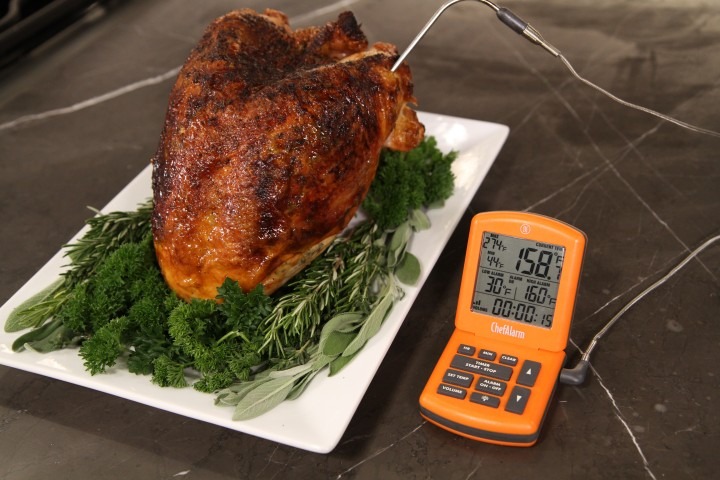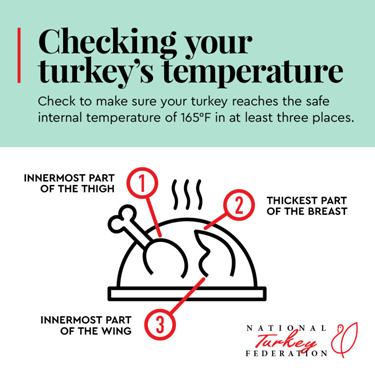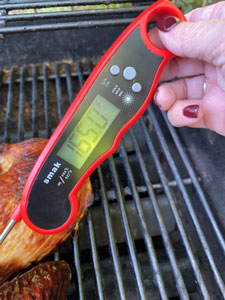As Thanksgiving approaches, many home cooks are preparing to roast a turkey for the big feast Getting the turkey just right is tricky business, but using a meat thermometer takes a lot of the guesswork out of the equation Properly placing the thermometer in the turkey breast ensures the meat cooks to a safe internal temperature without drying out.
In this article, I’ll walk through everything you need to know about thermometer placement to roast the perfect turkey breast With the right technique, you’ll impress your guests with a juicy, flavorful turkey centerpiece.
Why Thermometer Placement Matters
Cooking the turkey breast evenly to the proper internal temperature is crucial for both food safety and taste. If the thermometer isn’t placed correctly in the thickest part of the breast, you won’t get an accurate reading of the meat’s internal temperature. An inaccurate temperature reading could lead to undercooked or overcooked turkey.
Undercooked poultry can potentially cause foodborne illness. The USDA recommends cooking turkey to a minimum internal temperature of 165°F to kill any harmful bacteria.
Overcooking leads to dried out, stringy meat. No one wants that on Thanksgiving! Using your thermometer correctly ensures moist, tender turkey breast every time.
Choosing the Right Thermometer
To monitor the turkey’s temperature, you’ll need a good quality leave-in meat thermometer. Leave-in thermometers are designed to remain in the meat while it cooks in the oven.
The best leave-in thermometers have a thin probe and small sensor area. This allows you to insert the probe into the precise spot you want to measure. Popular options are the ChefAlarm and DOT thermometers from ThermoWorks.
For an instant temperature check, an instant read thermometer like the Thermapen Mk4 is ideal. Instant read thermometers give quick readings with the precision of a thin, narrow probe.
Make sure to calibrate your thermometer before use for the most accuracy. An ice bath or boiling water test can verify the calibration.
How to Place the Thermometer in a Turkey Breast
To correctly place your leave-in thermometer:
-
Identify the thickest part of the turkey breast, away from any bones. You want to find the thermal center, which will take the longest to cook.
-
Insert the probe horizontally into the thickest section, starting from the neck end of the breast.
-
Make sure the entire sensor area is inserted into the meat. For most leave-in thermometers, insert 1⁄2 – 1 inch of the probe.
-
The tip of the probe should be near the middle of the breast, not touching any bones or the cavity.
-
Secure the probe cable to keep it fixed in position during roasting.
Monitoring the Temperature
Once the thermometer is properly placed, you can track the internal temperature throughout the cooking process. Monitor it closely near the estimated finish time.
For food safety, the turkey needs to reach 165°F. However, carryover cooking can increase the temperature 5-10 degrees after the turkey is removed from the oven.
To avoid overcooking, I recommend taking the turkey out when the thermometer shows 160°F. Use an instant read to double check multiple spots before serving.
For juicy meat, don’t go above 165°F. As soon as it hits 165, take it out of the oven.
Alternative Thermometer Placement
While the thickest part of the breast is best, you can also place the leave-in thermometer in the thickest section of the thigh or stuffing if present. Just keep it out of the direct cavity.
If roasting a whole turkey, you can insert one probe into the breast and one into the thigh for the most accurate readout.
For boneless turkey breast, insert the probe into the center from above. Again, aim for the thickest section.
Thermometer Tips
-
Wash the probe before and after use to prevent cross-contamination.
-
Never leave a plastic instant read thermometer inside the oven.
-
Make sure the probe is not touching any bones, fat, or the pan.
-
Double check the temperature with an instant read thermometer before serving.
-
Let the thermometer readings stabilize before recording the temperature.
Signs Turkey Breast is Done
Along with monitoring thermometer temperature, look for these visual cues that the turkey breast is fully cooked:
-
The meat is opaque and no longer pink.
-
Juices run clear when pierced with a knife.
-
The thickest part of breast reaches 165°F.
-
The meat pulls apart easily.
Mastering the Perfect Turkey
Placement is just one aspect of cooking the ideal turkey breast. Proper thawing, seasoning, roasting temp, and resting time also impact the final results.
But accurate thermometer placement is the crucial first step to roasted turkey success. By inserting the leave-in probe into the thermal center and monitoring the temp, you can feel confident your turkey will turn out perfectly cooked.
Just follow the guidelines above for foolproof thermometer placement. With your trusty thermometer as your guide, enjoy mouthwatering turkey this Thanksgiving!

Where to Put the Thermometer in a Turkey

An important part of using any thermometer is the proper placement in the turkey. Unsure of where to put the thermometer in a turkey? Here are few tips to keep in mind:
- When preparing a whole turkey, insert the thermometer into the thickest portion of the turkey breast, the innermost portion of thigh and the innermost portion of the wing.
- Make sure the thermometer does not touch bone, gristle or the pan.
- When inserting the thermometer in a turkey breast or ground turkey patty, insert it from the side. The thermometer is easier to read and more accurate than when inserted from the top.
The internal temperature of your turkey (and any stuffing) should always reach 165°F.

According to the U.S. Food and Drug Administration, the percentage of consumers who own food thermometers has increased from 49 percent in 1998 to 70 percent in 2010. Both the National Turkey Federation and USDA recommend using a meat thermometer to ensure a delicious and safe meal.
Accurate temperatures, both in the oven and the turkey are important for quality and safety. A meat thermometer is a cook’s best friend when it comes time to prepare a meal.
Meat thermometers that can be calibrated for accuracy and instant-read/digital thermometers are our preferred choices. These types of thermometers are available at grocery, kitchen and hardware stores.
Don’t forget about your oven’s temperature! Check the oven thermostat and oven temperature to verify the oven setting. Recalibrate if necessary – a 25°F variation can make a 5 percent difference in cooked turkey yield. An oven that is too hot will dry and shrink the bird.
Check out USDA’s resource for more information on proper cooking temperatures.
This should be inserted into the turkey at the beginning of the cooking time and remain inserted in the bird while cooking. The temperature indicator will rise slowly as the turkey cooks. An oven-proof thermometer is ideal for the whole turkey and the turkey breast.
These thermometers enable you to measure the internal temperatures of meat with the most accurate reading in the quickest time possible. They are not designed to stay in the food during cooking. If you use this type, pull the turkey out of the oven far enough to insert the stem about 2 1/2 inches into the thickest part of the meat, but not touching bone or the roasting pan.
The sensing tip is a small indentation located about 1 1/2 inches from the end of the stem and must be fully inserted into the bird. (Look for a tiny dimple on the stem.) The temperature should register in about 15-20 seconds. Wipe with a sanitizer after each use and before the next use.
These are commonly found in the whole turkey and turkey breast. The “pop-up” thermometer device indicates the turkey has reached the final temperature for safety and doneness. Experts suggest the temperature be verified with a conventional thermometer.
USDA has a full listing of the various types of food thermometers available.
Food thermometers should be washed following use with hot soapy water and sanitized. Most thermometers, particularly digital and instant-read varieties, should not be immersed in water.
There are several ways to sanitize your thermometer:
- Use an alcohol swab to wipe the stem.
- Use a food-safe sanitizing solution, such as chlorine bleach and water, diluted according to the directions on the bottle, by holding it in the diluted mixture for a minimum of 10 seconds.
- Hold the stem in boiling water for no less than 30 seconds.
If using alcohol or a cleaning solution, make sure to wash the stem with soap and hot water to remove any residue.
How to Insert a Meat Thermometer into Turkey
FAQ
Is turkey done at 165 or 180?
Where to put leave in thermometer in turkey?
